| The Naked City | Nov 25 2014 |

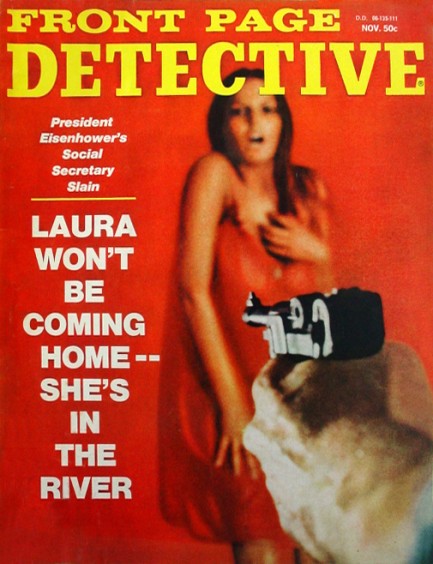
Front Page Detective shows on this November 1971 cover how to attract eyeballs with lurid art and titillating text. Eisenhower’s social secretary murdered? That sounds intriguingly political, but it turns out Eisenhower’s only connection is that his White House had more than a decade earlier employed the murder victim in a secretarial position. Though no political angle exists, the crime itself is still very interesting. Laura Carpi, scion of a prominent Philadelphia family, disappeared in February 1971. In June the decomposed body of a woman was found in New York City’s East River, labeled an accidental drowning victim, and twenty days later interred on Hart Island as a Jane Doe in the potter’s field there. After the body was identified as Carpi’s, the New York Times published a sensational story claiming that her head had been removed before burial for study by junior pathologists, or, according to some sources in the pathologist’s office, simply to be used as a desk ornament. The Times claimed that a technician had been cleaning out whatever grisly remnants of flesh were still attached to the skull and happened to find a bullet lodged in its neck tissue. Dealing now with a suspected homicide, police focused on missing persons, and eventually summoned Carpi’s dentist. Recognizing his own work, he made the positive identification.
The ME’s office became the center of a storm, with Chief Medical Examiner Milton Helpern blasting the Times story for insinuating that “the doctors in this office are cutting off people’s heads to make ashtrays.” He pronounced the entire article “grossly distorted.” Perhaps it was, but uncovering a murder by chance never looks good, and he didn’t help his cause when he responded to a question about why his staff had failed to discover the bullet by saying that he ran a mortuary, not a graveyard, and was extremely busy. Though his answer was callous, it was also correct. His office had a contant flow of bodies coming through—that year more than 1,800 alone that had been victims of murder—and his staff was overworked. Add to this the facts that Laura Carpi had thick hair that concealed the small caliber entry wound at the base of her skull, the slug had left no exit wound, and the head had been four months in the water, and it’s possible to see how mistakes could be made. As to why the head was kept, the unconvincing official reason was that it was because the dentalwork would allow for possible future identification—which only made sense if all the Jane and John Does on Hart Island were also headless.
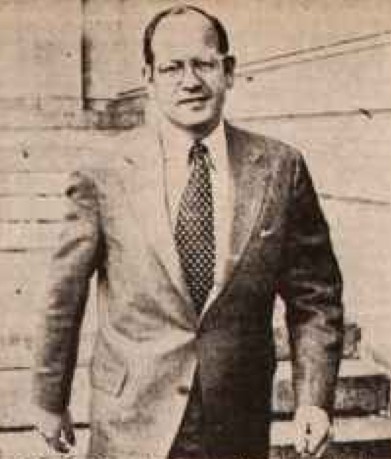 In any case, the finger of suspicion for the murder immediately pointed toward Carpi’s estranged husband Colin, at right, who was battling for custody of their four children. Not only would the loss of this battle and subsequent divorce settlement wipe him out financially, but he was also well aware that his wife had been seeing another man. For various reasons—jurisdictional issues and general reluctance to pursue the crime—Colin Carpi didn’t go to trial for two more years. A mountain of circumstantial evidence pointed at him, but his acquittal was deemed by most legal experts to be the right decision. The prosecution simply bungled its presentation to the jury, and even if the courtroom aspect had been perfect, much of Colin Carpi’s suspicious behavior could be chalked up to the circumstances around the custody battle and his wife’s affair. Perhaps a not-guilty verdict was an anti-climax after the high drama associated with the identification of Laura Carpi’s body, but not finding the perp is the way it often goes in true crime, and real life.
In any case, the finger of suspicion for the murder immediately pointed toward Carpi’s estranged husband Colin, at right, who was battling for custody of their four children. Not only would the loss of this battle and subsequent divorce settlement wipe him out financially, but he was also well aware that his wife had been seeing another man. For various reasons—jurisdictional issues and general reluctance to pursue the crime—Colin Carpi didn’t go to trial for two more years. A mountain of circumstantial evidence pointed at him, but his acquittal was deemed by most legal experts to be the right decision. The prosecution simply bungled its presentation to the jury, and even if the courtroom aspect had been perfect, much of Colin Carpi’s suspicious behavior could be chalked up to the circumstances around the custody battle and his wife’s affair. Perhaps a not-guilty verdict was an anti-climax after the high drama associated with the identification of Laura Carpi’s body, but not finding the perp is the way it often goes in true crime, and real life.
| The Naked City | Oct 1 2014 |

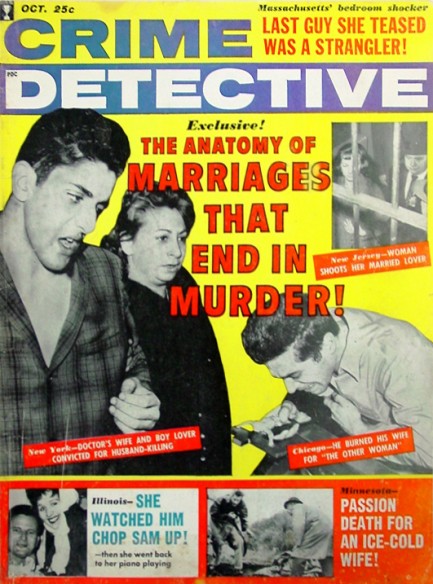
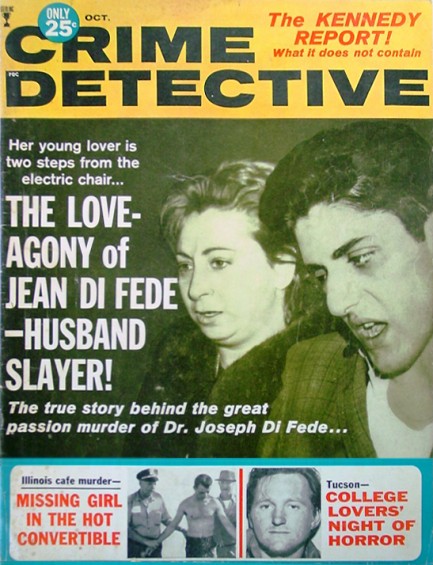
These two issues of Crime Detective, which appeared today in 1962 and 1964 respectively, both feature the same cover photo—each a reverse of the other—of Jean DiFede and Armando Cossentino. DiFede and Cossentino, who were thirty-six and nineteen, were May-December lovers convicted of murdering DiFede’s husband Dr. Joseph DiFede in order to collect a $72.000 life insurance policy (about $560,000 in today’s money). Dr. DiFede was attacked in his bedroom with a hammer and carving knife, and the disarray of the scene showed that he had battled fiercely for his life before succumbing to multiple blows and seven stab wounds. A third person on  the scene later turned eyewitness against the lovers, claiming Dr. DiFede gasped to his wife with his last words, “I forgive you everything… Don’t kill me.” Meanwhile Cossentino stood over him and shouted, “Die! Die! Die!”
the scene later turned eyewitness against the lovers, claiming Dr. DiFede gasped to his wife with his last words, “I forgive you everything… Don’t kill me.” Meanwhile Cossentino stood over him and shouted, “Die! Die! Die!”
The eyewitness account (he said the extent of his participation had been helping to clean the crime scene because he feared for his life) was damning enough on its own. Police also discovered that Jean DiFede had bought Cossentino a new convertible, rented an apartment for him, and went on public dates with him. And just for good measure the all-male jury was repeatedly reminded that Cossentino was only two years older than Jean DiFede’s oldest son, who had been instructed to refer to her by her name rather than “mom.” When the guilty verdicts came down, Cossentino was sentenced to die in the electric chair and DiFede got twenty years. Upon hearing her sentence she screamed, “If I have to spend twenty years in jail I’d rather be dead!” As it turned out, neither of them died in prison. Cossentino’s sentence was commuted to life, and both eventually earned parole.
| Vintage Pulp | May 30 2013 |

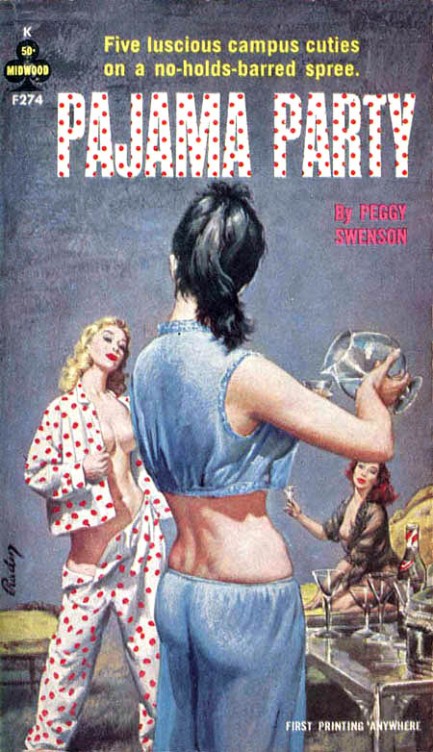
Above is a cover for 1963’s Pajama Party, a book written by Peggy Swenson, who was in reality Richard E. Geis. Interesting fellow, Geis—he specialized in beatnik and counterculture sleaze, churning out lightweight novels like Bongo Bum, Beat Nymph, and Like Crazy, Man, and was indicted for obscenity over a novel called Three-Way Apartment. This was in 1964. Geis went to trial twice, first in California, then in federal court in Iowa. He was convicted but the case made its way to the U.S. Supreme Court where the panel overturned the verdict, thus making Geis’s Three-Way Apartment one of those forgotten but important books that helped free publishing from the grip of reactionary prudes.
After Geis’s close call with the feds he must have felt artistically liberated, because his writing promptly went to the far ends, so to speak, of taste. Some titles: Anal Husbands and Deviant Wives, The Endless Orgy, Women and Bestiality, and, our two favorites—Orality ’69 and its sequel Orality ’70. Pajama Party was not so notable a book as those—five co-eds have a sleepover that involves a pillow fight, skinny-dipping, a striptease contest and a game of dares, before finally getting down to a little Sapphic lust—but we really like the Paul Rader cover, so there you go.
| The Naked City | Mar 28 2013 |


Yesterday in Manchester, England, 46-year-old Stephen Seddon was found guilty of murdering his parents for £235,000 in insurance money. Robert and Patricia Seddon were found shot dead in their home in July 2012, a sawed-off shotgun on the scene indicating a possible murder/suicide. But ballistic experts decided that scenario was not possible, and soon Stephen Seddon—who had boasted to acquaintances before his parents’ deaths that he was about to come into a large sum of money—was arrested. Yesterday’s conviction marked the final chapter of just another sad, senseless murder tale. What’s shocking, though, is the preamble.
 happened to be carrying a knife with which to cut his seatbelt and a wheel lock with which to smash out the driverside window as the car went down. Oh, and several witnesses saw him jumping up and down on the roof of the car as it sank. Red flag? You’d tend to think so.
happened to be carrying a knife with which to cut his seatbelt and a wheel lock with which to smash out the driverside window as the car went down. Oh, and several witnesses saw him jumping up and down on the roof of the car as it sank. Red flag? You’d tend to think so.| Vintage Pulp | Jan 18 2013 |

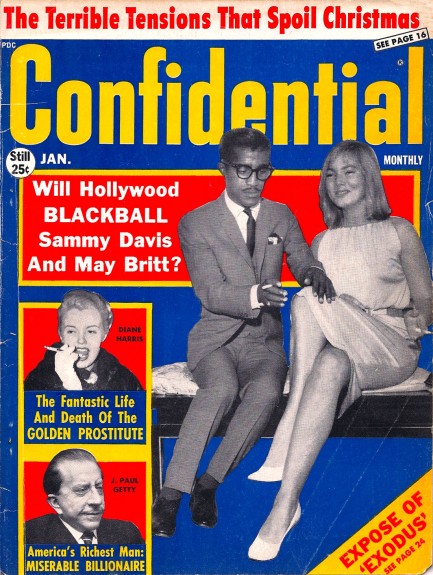
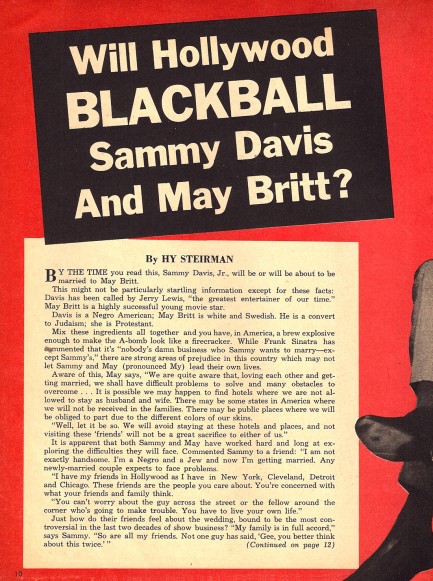
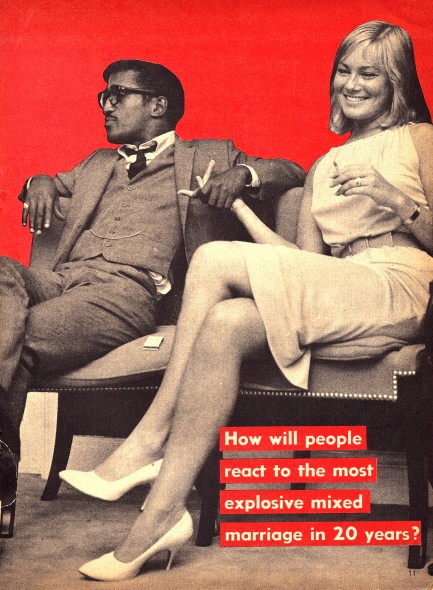
Today we have a January 1961 issue of Confidential for you, with cover stars Sammy Davis, Jr. and May Britt. Since we’ve already discussed Sammy and May of late, and even made her a recent femme fatale, we’ll skip past them and focus on another interesting story—the tale of Diane Harris, who shot to notoriety as a witness in the infamous Minot Jelke pimping trial of 1952. We wrote about it back in 2009—Jelke was an oleomargarine heir who was cut off from his trust fund and decided to turn his girlfriend Patricia Ward into a prostitute in order to make ends meet. Ward became known as the “Golden Girl of Vice” and “The Golden Girl of Café Society,” which is why it’s interesting that Confidential calls Diane Harris “The Golden Prostitute.” Apparently Jelke had the Midas touch.
Confidential wastes no time in its article. It begins: She gave herself a title… Lady Diana Harrington. The New York D.A. gave her another… the Golden Girl of Café Society. Houston police gave her a third, less flamboyant title… prostitute. Uh oh—the New York District Attorney’s nickname for Harris is identical to Patricia Ward’s nickname. After a few more paragraphs of reading, it becomes clear that Confidential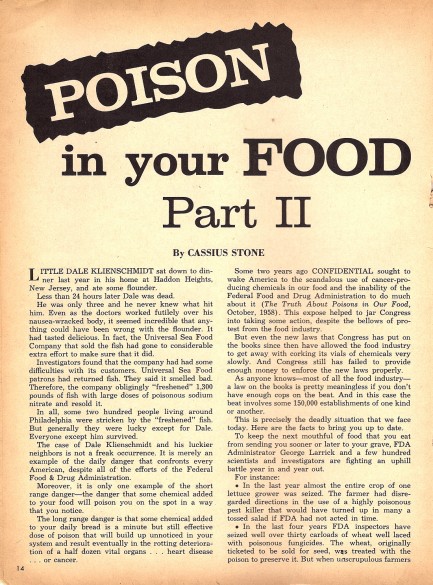
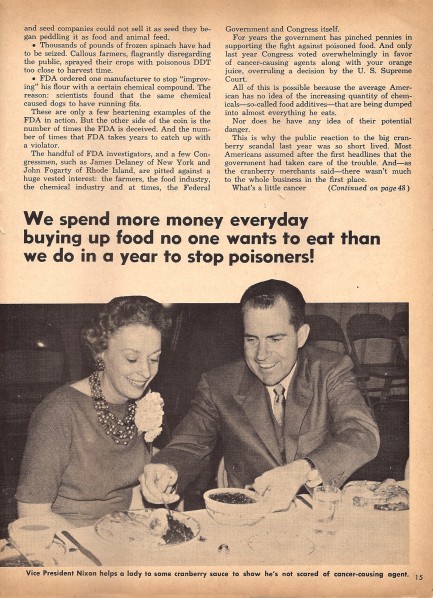
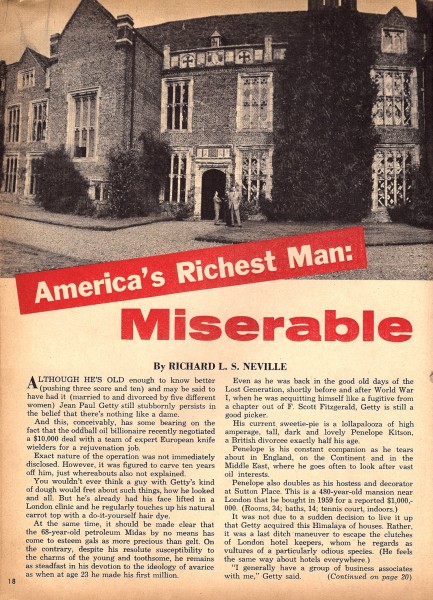
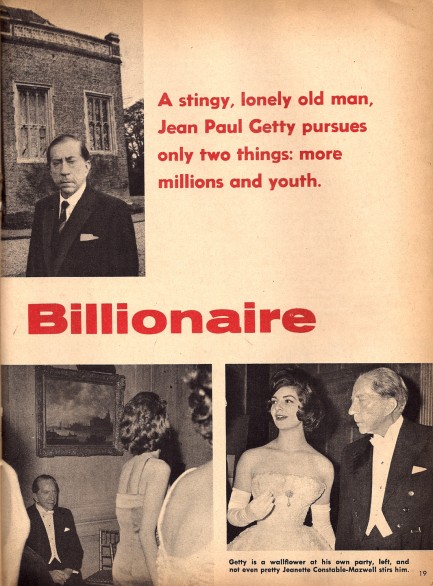 believes the Golden Girl is Diane Harris—not Patricia Ward. While it’s true that Harris did use some aliases, including Lady Diana Harrington and Mary Lou Brew, nowhere is the name Ward mentioned as a pseudonym.
believes the Golden Girl is Diane Harris—not Patricia Ward. While it’s true that Harris did use some aliases, including Lady Diana Harrington and Mary Lou Brew, nowhere is the name Ward mentioned as a pseudonym.
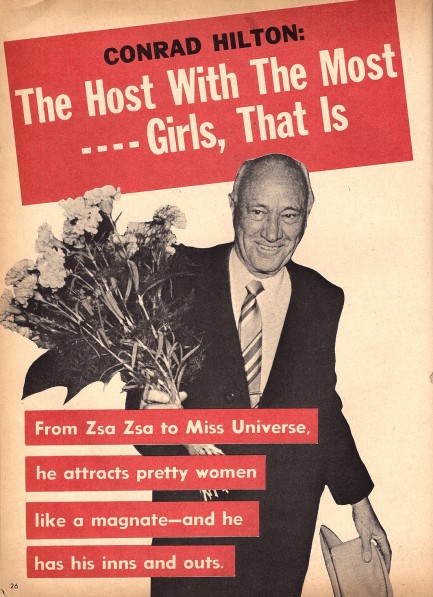
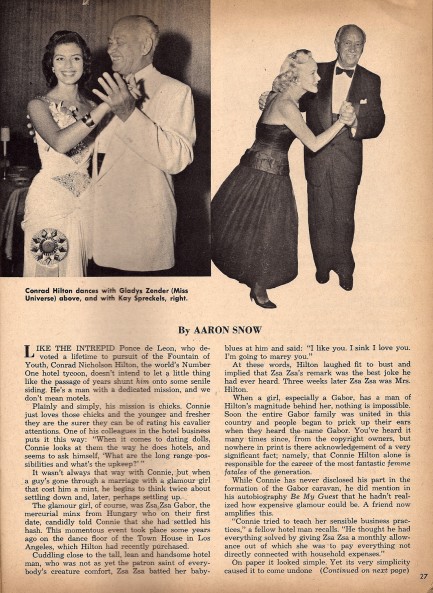 point of a Hollywood motion picture misidentifying her. She was indeed Minot Jelke’s girlfriend, whereas Harris was just a fellow high dollar prostie (and corroborating witness), so perhaps some clever scribe, or even the writers of the 1995 movie, decided that such a catchy nickname would be better applied to the girlfriend. At least that’s the way it looks to us.
point of a Hollywood motion picture misidentifying her. She was indeed Minot Jelke’s girlfriend, whereas Harris was just a fellow high dollar prostie (and corroborating witness), so perhaps some clever scribe, or even the writers of the 1995 movie, decided that such a catchy nickname would be better applied to the girlfriend. At least that’s the way it looks to us.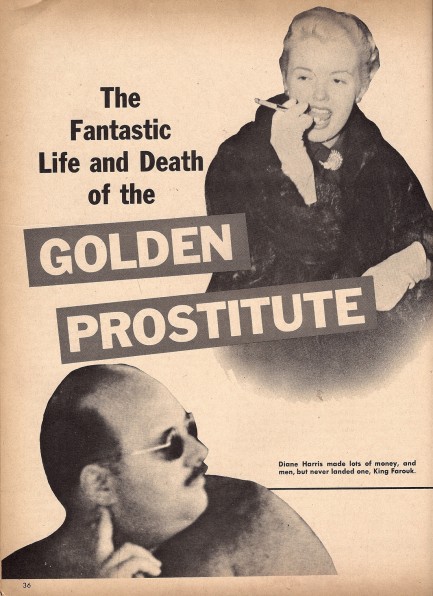
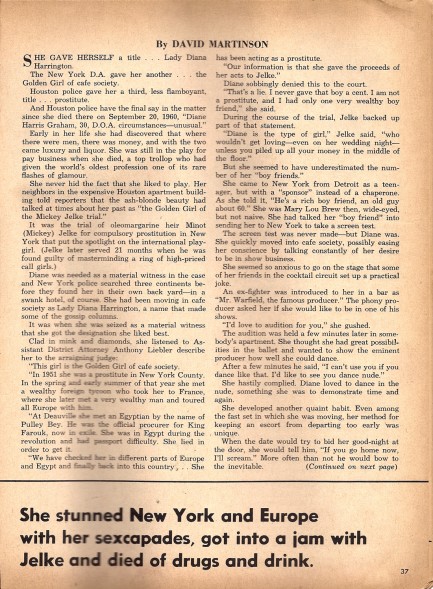
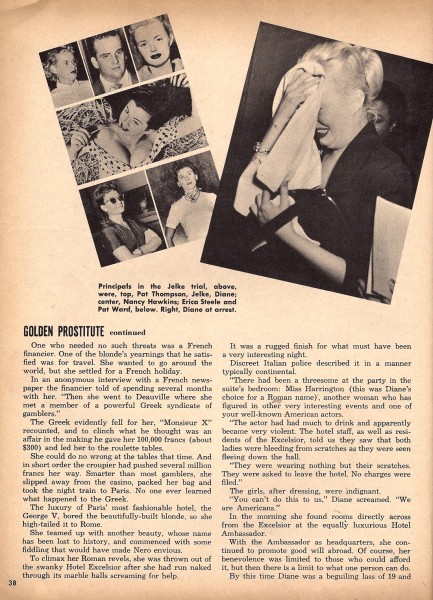
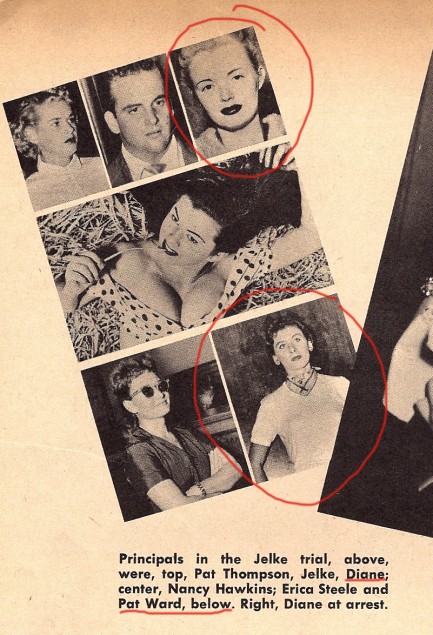
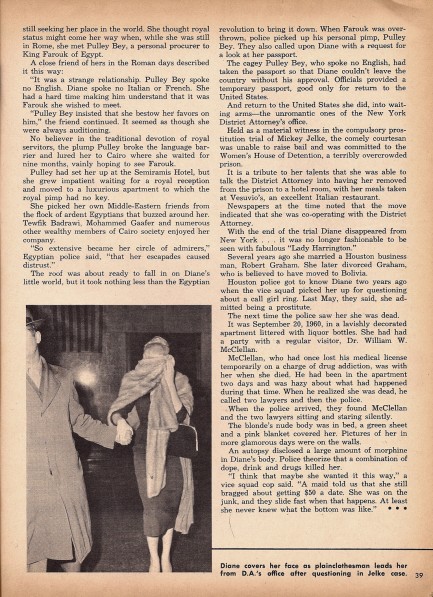 in more glamorous days were on the walls. An autopsy disclosed a large amount of morphine in her body. Police theorize that a combination of drink and drugs killed her.
in more glamorous days were on the walls. An autopsy disclosed a large amount of morphine in her body. Police theorize that a combination of drink and drugs killed her.| The Naked City | Nov 5 2012 |

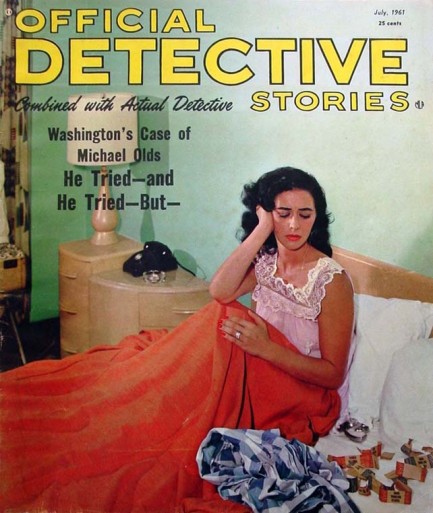
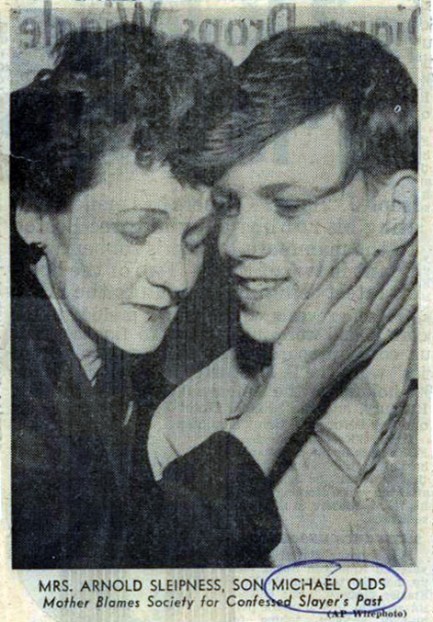 Olds was convicted of murder and sentenced to life in prison. His mother was in court the day of sentencing, at right, and while she sounded a note of regret that her and her son’s lives had turned out so badly, Michael was philosophical. He blamed only himself for his predicament. But the American public, as well as many behavioral experts, felt there was blame to go around. One of Michael Olds’ state-appointed psychiatrists said: “In a day when we are thinking about shooting rockets to the moon, we should not allow conditions to exist where a child is starved emotionally and shuttled about.” A local juvenile authority said: “The boy pulled the trigger, but the background of the whole sordid mess began the moment he was brought into the world.”
Olds was convicted of murder and sentenced to life in prison. His mother was in court the day of sentencing, at right, and while she sounded a note of regret that her and her son’s lives had turned out so badly, Michael was philosophical. He blamed only himself for his predicament. But the American public, as well as many behavioral experts, felt there was blame to go around. One of Michael Olds’ state-appointed psychiatrists said: “In a day when we are thinking about shooting rockets to the moon, we should not allow conditions to exist where a child is starved emotionally and shuttled about.” A local juvenile authority said: “The boy pulled the trigger, but the background of the whole sordid mess began the moment he was brought into the world.”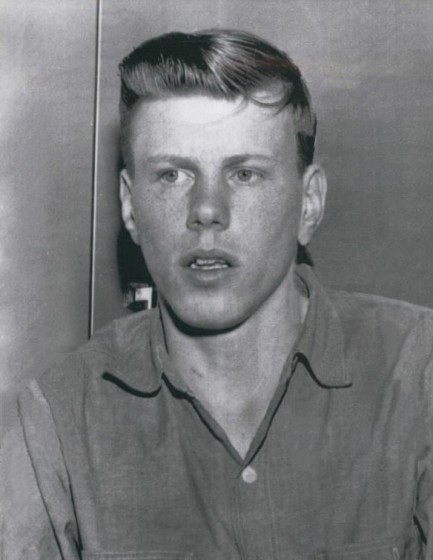 changed was that most Americans had hardened toward crime to the extent that they considered the questions immaterial. All that mattered was to make sure Michael Olds preyed on no more innocent people. And that’s exactly what happened. He received two life sentences with no possibility of parole.
changed was that most Americans had hardened toward crime to the extent that they considered the questions immaterial. All that mattered was to make sure Michael Olds preyed on no more innocent people. And that’s exactly what happened. He received two life sentences with no possibility of parole.| Intl. Notebook | Mar 7 2012 |

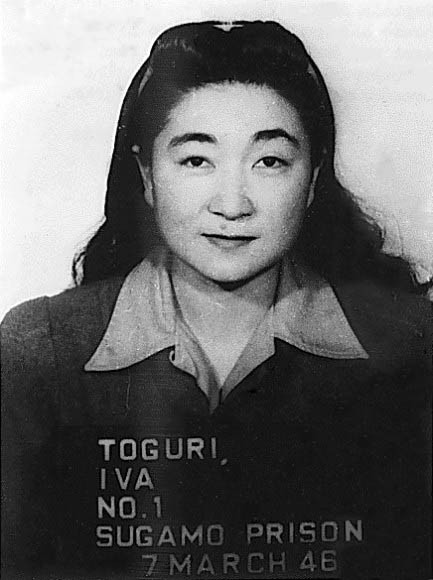
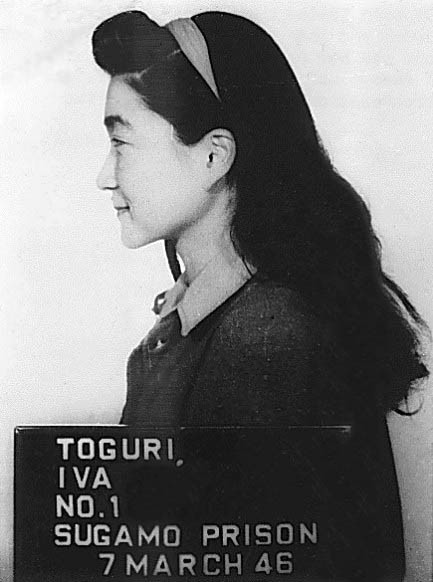
Above, two mugshots from today 1946 of Iva Toguri D’Aquino, who was one of many women who broadcast English-language radio from Tokyo during World War II. These broadcasts were aimed at Allied personnel in the Pacific, and the soldiers referred to all the women collectively as Tokyo Rose, despite whatever they actually called themselves on air. D’Aquino called herself Orphan Ann, and her radio stints were limited to twenty-minute segments on Radio Tokyo. It wasn’t much time, but her low, raspy voice made an impression on listeners. What did she say? History.net answers that question by providing an example of a typical D’Aquino intro:
Hello there, Enemies! How's tricks? This is Ann of Radio Tokyo, and we're just going to begin our regular program of music, news and the Zero Hour for our friends—I mean, our enemies!—in Australia and the South Pacific. So be on your guard, and mind the children don't hear! All set? OK. Here's the first blow at your morale—the Boston Pops playing ‘Strike Up the Band!’
When the war ended D’Aquino, who was an American citizen, was taken into custody and shipped back to the U.S., where she was tried and convicted of treason. There was no actual proof that she had done anything traitorous—in fact her humor-tinged broadcasts had often undermined her Japanese employers’ intentions—but she nevertheless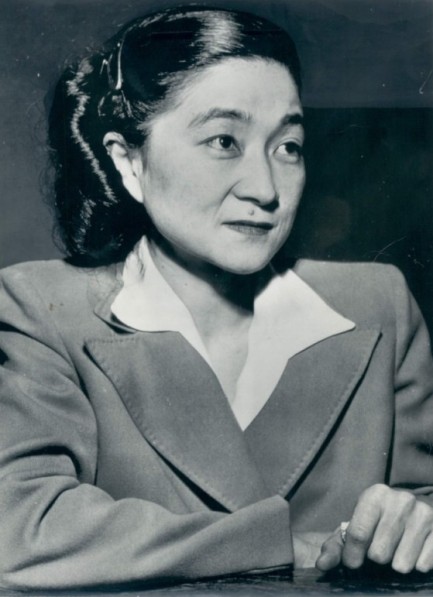 languished in prison for six years. D’Aquino’s legal troubles only ended in 1977, when U.S. president Gerald R. Ford pardoned her after evidence emerged that witnesses had lied at her trial. Cleared of wrongdoing, and the constant threat of deportation lifted, D’Aquino lived the rest of her days quietly and died in 2006 at age 90.
languished in prison for six years. D’Aquino’s legal troubles only ended in 1977, when U.S. president Gerald R. Ford pardoned her after evidence emerged that witnesses had lied at her trial. Cleared of wrongdoing, and the constant threat of deportation lifted, D’Aquino lived the rest of her days quietly and died in 2006 at age 90.
| Intl. Notebook | Dec 17 2011 |

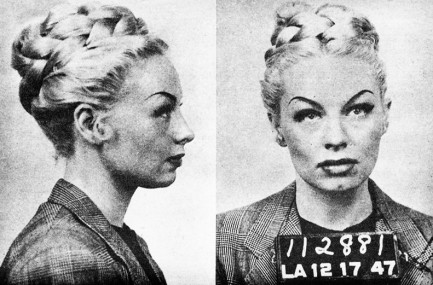
This mugshot of Lili St. Cyr appears on literally hundreds of sites around the internet, but we’re posting it anyway so we can correct some misinformation. Every source we saw—all of them—refer to this as St. Cyr’s September 1951 booking photo, but it’s actually from today in 1947, a fact that should be abundantly clear from the date under her chin: 12/17/47. The arrest, which was for lewd behavior, occurred in Los Angeles, and when St. Cyr appeared in court several months later she lost her case and was fined fifty dollars—a slap on the wrist. Things didn’t go so leniently for the owner of the Follies Theater, where St. Cyr had performed. He was sentenced to thirty-nine days in jail. See plenty more St. Cyr by clicking her keywords below.
| Hollywoodland | Sep 10 2011 |


Actress and former Playboy model Victoria Vetri, aka Victoria Rathgeb, aka Angela Dorian pleaded no contest to attempted voluntary manslaughter earlier this week and was sentenced to nine years in prison. Last October Vetri was arrested after shooting her husband in the back, and since then has been in custody, unable to produce the million-plus dollars needed to make bail.
Vetri claims her husband, Bruce Rathgeb, precipitated the shooting by slapping her in the face. Rathgeb, of course, says no slap was involved and his wife is simply a verbally abusive lunatic who was constantly accusing him of cheating. Vetri could have gotten life in prison if convicted of attempted murder, the original charge, so being offered a chance to accept the lesser offense of attempted manslaughter represents a victory—though a Pyrrhic one, without doubt. We’ll close the door on Miss Vetri with a shot of her in 1967, when she was a young centerfold calling herself Angela Dorian and could never have imagined, we’re pretty sure, what life had in store for her.
| The Naked City | Aug 18 2011 |

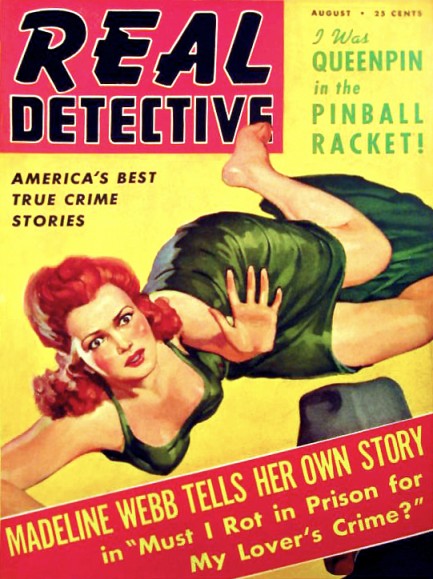
This Real Detective from August 1942 hit newsstands during the height of America’s conflict in the Pacific against the Japanese and it tells the story of Madeline Webb, who was the central figure in a murder case so sensational that it managed to distract the country, however briefly, from war. Webb had moved from Stillwater, Oklahoma to New York City with small town dreams of being a Broadway star. Instead she met a petty crook named Eli Shonbrun and fell in love. Webb was living on an allowance from home, but Shonbrun’s income was more sporadic—he survived by stealing women’s jewelry. Eventually he needed another score and, along with two accomplices named John Cullen and Murray Hirschl, he hatched a scheme to rob a wealthy acquaintance of Webb’s, a woman named Susan Flora Reich.
But when the robbery was over Reich was dead, suffocated by the adhesive tape that had been placed over her mouth. Eli Shonbrun and company went into hiding, but the police soon tracked them down, whereupon Hirschl immediately made a deal to testify against the others. He admitted helping to plan the crime, but swore he was not present in the hotel room where it occurred. Madeline Webb also denied being present, and Shonbrun backed up her claim, but Hirschl said she was lying and had actually lured 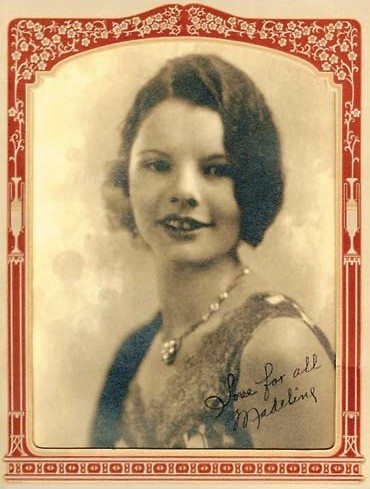 Reich to the hotel. A jury of twelve men deliberated for five hours and returned a verdict of guilty for all three defendants. Shonbrun and Cullen were sentenced to death and Webb was given life in prison. When her punishment was announced in court she sobbed, “Please, please, I didn't!” Shonbrun cried, “You have crucifed her!”
Reich to the hotel. A jury of twelve men deliberated for five hours and returned a verdict of guilty for all three defendants. Shonbrun and Cullen were sentenced to death and Webb was given life in prison. When her punishment was announced in court she sobbed, “Please, please, I didn't!” Shonbrun cried, “You have crucifed her!”
What seemed to mesmerize the American public was the spectacle of Webb and Shonbrun clinging to their love in the face of adversity. They had frequently disrupted the trial with outbursts of support for each other. Whenever Webb seemed to wither Shonbrun managed to pass her notes of encouragement. On the few occasions they came into physical contact they kissed and exchanged “I love yous.” And when Shonbrun’s date with the executioner came in April 1943, he received a final love letter from Webb. He read it in the death chamber at Sing Sing Prison, then surrendered it to the warden to be destroyed. Five minutes after being strapped into the electric chair Eli Shonbrun was dead.
Madeline Webb served twenty-five years at Westfield State Farm in Bedford Hills, New York, and was by all accounts a model inmate. She promoted educational programs for imprisoned women, taught many illiterate inmates to read, and ran the prison library. Her life sentence carried no possibility of parole, but her sentence was commuted in 1967. After her release she returned to Stillwater where she worked with various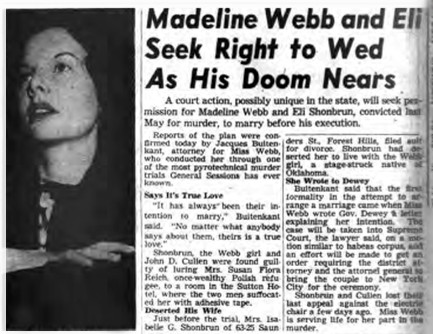 community organizations and cared for her elderly mother, who had spent her life savings on her daughter’s legal fees. Webb died of cancer in 1980 at age sixty-seven, and she did so still protesting her innocence. She was indeed an unlikely murderer. Her family had money back in 1942, and if she had required any she need only have sent a telegram asking for it. But just as New York City proved too much for her show business ambitions, its men may have proved too much for her better judgment. It's entirely possible she was simply too lovestruck by the rough and tumble Eli Shonbrun to derail his scheme. Some light could possibly be shed on this question if the content of her last letter was known—but that went to grave with her.
community organizations and cared for her elderly mother, who had spent her life savings on her daughter’s legal fees. Webb died of cancer in 1980 at age sixty-seven, and she did so still protesting her innocence. She was indeed an unlikely murderer. Her family had money back in 1942, and if she had required any she need only have sent a telegram asking for it. But just as New York City proved too much for her show business ambitions, its men may have proved too much for her better judgment. It's entirely possible she was simply too lovestruck by the rough and tumble Eli Shonbrun to derail his scheme. Some light could possibly be shed on this question if the content of her last letter was known—but that went to grave with her.
 |
 |




































































